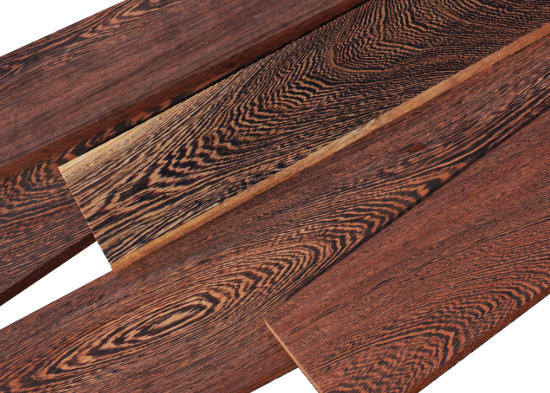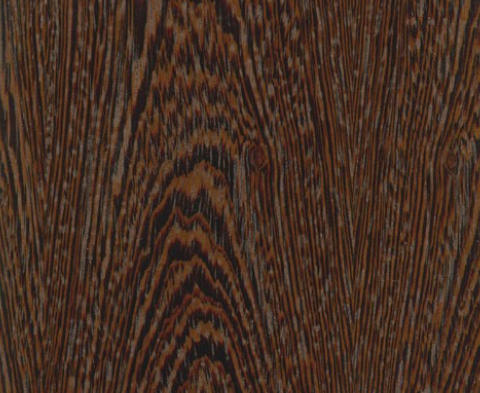










Content Menu
>> Origin and Physical Properties
● The Meaning of a Wenge Finish
>> Common Applications of Wenge Finish
● How to Achieve a Wenge Wood Finish
● Applications of Wenge Wood and Finish
>> Furniture and Interior Design
>> Musical Instruments and Artisanal Crafts
● Advantages of Wenge Wood Finish
● Environmental Responsibility
● FAQs About Wenge Wood Finish
>> 1. What color best describes Wenge wood?
>> 2. Is Wenge harder than oak?
>> 3. Can Wenge finish be applied to other woods?
>> 4. How should Wenge finishes be maintained?
>> 5. Is Wenge wood sustainable?
Wenge wood finish represents one of the most luxurious and visually striking surfaces in modern interior and furniture design. Derived from Wenge wood (Millettia laurentii), a tropical hardwood native to Central and West Africa, the finish is admired for its deep chocolate-brown color, almost black streaking, and rich natural texture. Beyond its aesthetic charm, Wenge finish embodies exceptional durability and timeless sophistication, making it a cornerstone in luxury furniture, flooring, and architectural detailing.[1][4][10]

Wenge trees grow primarily in Central Africa—particularly in Cameroon, Congo, and Gabon. The heartwood varies from medium brown to almost black, often displaying fine, close blackish veins that produce a dramatic aesthetic contrast. This visual depth has made it one of the world's most sought-after exotic woods.[10][1]
The density of Wenge, averaging 880–910 kg/m³, gives it exceptional strength and resistance. It ranks about 8,600 N on the Janka hardness scale, making it harder than oak, walnut, and even teak. This hardness ensures longevity but also makes the wood somewhat difficult to cut and sand, requiring specialized tools and expertise.[10]
The grain of Wenge is straight or slightly interlocked with a medium to coarse texture. Its pores are relatively wide, so artisans often use grain fillers to smooth the surface. Natural finishes using oil or wax highlight the grain, while lacquer or polyurethane enhances durability and luster.[4][10]
Its color is one of its most striking assets — the deep, espresso-like hue combined with purplish undertones can make even minimalist furniture exude elegance and warmth. Over time, Wenge wood may lighten slightly under sunlight, giving it a sophisticated aged character.
A Wenge finish refers to any surface treatment that replicates or enhances the appearance of real Wenge wood — a deep brown hue with visible dark streaking. Products made from other hardwoods (such as ash or oak) are often stained or laminated to imitate Wenge, offering a more cost-effective alternative while capturing its dark, luxurious appearance.[11][12]
This type of finish epitomizes modern elegance and understated luxury. Whether used for kitchen cabinetry, wall panels, or furniture, the Wenge finish evokes depth, sophistication, and tranquility in both residential and commercial interiors.[13][14][10]
Wenge finishes can be found in:
- High-end furniture — including dining tables, bed frames, and storage units
- Architectural interiors — wall panels, trims, and stair treads
- Flooring — engineered Wenge hardwoods provide deep, luminous tones
- Musical instruments — especially guitar bodies and necks, where tonal richness is essential[1][4][10]
Many designers pair Wenge finishes with lighter materials — glass, chrome, and white marble — to create contrast and visual balance. In office interiors, its dark tone projects professionalism and authority, while in homes it adds intimacy and luxury.
Because of Wenge's density and high silica content, sandpaper tends to dull quickly. Craftsmen typically begin with coarse grit (120–150) before progressing to fine grit (320–400) to ensure a smooth surface. However, dust and splinters from Wenge can be irritating or even toxic, so personal protective gear is essential during sanding and cutting.[15][1]
1. Oil Finish (Danish, Tung, or Linseed Oil)
Penetrates deeply into the grain, enriching the dark tone and emphasizing contrast. Oils produce a warm, satin finish ideal for furniture.
2. Varnish or Polyurethane
Used for durability and resistance to moisture — excellent for floors or countertops. Oil-based varieties deepen color, while water-based versions preserve the natural brown tone.[15][1]
3. Wax or Shellac Finish
Provides medium protection with an appealing sheen suitable for decorative objects.
4. Staining and Veneering Options
For projects not using genuine Wenge, dark brown or ebony stains can simulate the look effectively on oak or walnut veneers.[11][15]
Wenge's dense, dark grain structure makes it ideal for luxury furniture — dining tables, cabinets, bedroom sets, and shelving units. Its resilience to wear adds long-term value to pieces that endure years of use. Furniture finished with Wenge stain or veneer elevates interiors with minimalistic sophistication and is often used in hotel lobbies, luxury apartments, and executive offices.[2][8][4]
Solid or engineered Wenge flooring offers exceptional scratch resistance and subtle sheen. Architects prefer it for staircases and hallways subject to heavy traffic. Despite its high cost, engineered Wenge flooring allows the same aesthetic appeal at a reduced price while maintaining structural stability.[1]
Due to its high density and tonal depth, Wenge is widely used in guitar bodies, basses, and woodwinds. Its tonal profile favors low frequencies and clear resonance, earning it favor among professional luthiers. It also finds uses in small crafts, chessboards, tool handles, and decorative carvings.[6][4]
Wenge's antibacterial surface and minimal porosity make it suitable for cutting boards, serving trays, or kitchen furniture. Its dark, refined coloring pairs elegantly with stainless steel or ceramic countertops. Even in kitchens, Wenge creates a sumptuous blend of warmth and modernity.[10]

Wenge wood finish holds multiple advantages that explain its demand in high-end furniture and architectural detailing :[16][10]
- Rich, Exotic Appearance — Deep chocolate hues with fine black veins exude natural elegance.
- Outstanding Hardness — Resistant to scratching and wear; ideal for high-contact surfaces.
- Durability and Rot Resistance — Naturally resistant to insects and decay.
- Dimensional Stability — Rarely warps, expands, or contracts in varying humidity.
- Sustainability Options — Replicated Wenge laminates reduce reliance on endangered species.
However, these benefits come with challenges:
- High Cost and Scarcity — Due to conservation restrictions and limited harvesting.
- Difficult Workability — Requires specialized tools and protective handling.
- Sunlight Sensitivity — Prolonged exposure can cause slight fading over time.
Maintaining a Wenge finish is straightforward but requires awareness :[4][15]
1. Cleaning: Use a soft, damp cloth and mild detergent. Avoid alcohol-based cleaners.
2. Oil Refreshing: Apply maintenance oils periodically for sheen restoration.
3. Temperature and Humidity Control: Keep away from heating vents and direct UV rays.
4. Prevention of Scratches: Avoid abrasive sponges; use felt pads under furniture legs.
Well-maintained Wenge wood continues to deepen in beauty over decades, often developing a graceful patina admired by collectors and designers alike.
Due to overlogging, Millettia laurentii is listed as Endangered by the IUCN. Many global manufacturers now emphasize FSC-certified sources or engineered Wenge veneers to ensure sustainable trade. Eco-friendly alternatives, such as European oak dyed in Wenge-like tones, provide the same look with a smaller ecological footprint.[17][10]
A Wenge wood finish is much more than a surface color—it's a design statement rooted in nature's strength and craftsmanship's precision. Its rich tone, durability, and texture bring sophistication to any interior, from minimalist apartments to grand architectural builds. Whether natural or replicated, a Wenge finish conveys timeless elegance, combining luxury and practicality. With sustainable sourcing and careful maintenance, it will remain a hallmark of refined taste for years to come.

Wenge features a dark espresso-brown tone with black and purple undertones that can approach coal-black when oiled or lacquered.[18][19]
Yes. Wenge's Janka rating of 8,600 N makes it notably harder and longer-lasting than oak or ash.[1][10]
Yes. Through staining or laminates, other woods like oak, birch, or ash can adopt a Wenge-inspired finish, offering similar looks at a fraction of the cost.[12][11]
Use mild cleaning agents, reapply natural oils regularly, and limit direct sunlight for consistent color retention.[4][15]
Natural Wenge trees are endangered, so opting for FSC-certified or engineered veneers ensures sustainability while achieving the same rich aesthetics.[17][10]
[1](https://duffieldtimber.com/the-workbench/timber-trends/timber-species-guide-wenge)
[2](https://www.etsy.com/market/wenge_wood_furniture)
[3](https://www.facebook.com/groups/woodworkingforbeginner/posts/2956169211204351/)
[4](https://glamorwood.com/types-of-wood/wenge-wood/)
[5](https://www.finewoodworking.com/forum/finishing-wenge)
[6](https://www.youtube.com/watch?v=ksUYHcgCzK4)
[7](https://sawmillcreek.org/threads/finishing-wenge.124216/)
[8](https://www.1stdibs.com/furniture/material/wenge/)
[9](https://brandtcph.com/en-in/collections/crossbar-finish-wenge-wood)
[10](https://lignawooddesign.com/blog/wenge-wood-uses/)
[11](https://www.nobroker.in/forum/what-is-a-wenge-finish-on-furniture/)
[12](https://www.advantagelumber.com/wenge.htm)
[13](https://interiorhub.decorexpro.com/en/cvet-venge-v-interere-95-foto-558)
[14](https://abelyfashion.livepositively.com/wenge-wood-the-dark-elegance-transforming-modern-interiors/)
[15](https://www.shdtimber.com/how-to-finish-wenge-wood.html)
[16](https://www.timbersource.co.uk/blog/3-great-benefits-working-wenge-timber)
[17](https://www.rarewoodsusa.com/species/wenge/)
[18](https://piktochart.com/tips/what-color-is-wenge)
[19](https://www.wood-database.com/wenge/)